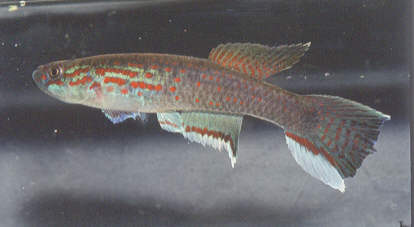Aphyosemion pascheni pascheni (Ahl 1928)

A.pascheni
pascheni. Wild male collected 20 km northeast
of Kribi, Cameroon.
Photo courtesy
of Ed Pürzl.
Aphyosemion pascheni pascheni (Ahl 1928)

A.pascheni
pascheni. Wild male collected 20 km northeast
of Kribi, Cameroon.
Photo courtesy
of Ed Pürzl.
| Meaning of Name |
After Herr Paschen, the original collector. | |||
| First Description |
Ahl E. 1928. Beiträge zur Systematik der africanischen Zahnkarpfen. Zoologischer Anzeiger 79 (3-4): p 122-123, figure. | |||
| Size |
5 cm | |||
| Meristics |
| |||
| Karyotype |
n = 12, A = 24 (Scheel 1974) | |||
| Sub-Genus |
Mesoaphyosemion | |||
| Group |
calliurum | |||
| Synonyms |
| |||
Populations
|
| |||
| Type Locality |
Longji, southwestern Cameroon. | |||
| Distribution |
Restricted to the M'polongwe River drainage system in the area of Longji, southwestern Cameroon. | |||
| Habitat |
Sheltered pools & swamps in brooks along coastal plain rainforest areas. Water analysis of their natural habitat was - water temperature 23·5°C, pH 5·7, DH 1. | |||
| Distinguishing Characteristics | ||||
| Colour/Pattern Variability | Low | |||
| History |
Ahl described them as Fundulus pascheni in 1928 from 4 specimens caught near Longji, a small town on the coast of southern Cameroon. Holly examined these types in 1930 & changed some of the data. In 1966 Scheel collected in the Longji area. In 1972 they were re-discovered & considered to be A.ahli for a time. In 1973 the sp. entered the BKA but enthusiasm
was low for them & offspring were notably 'weak' producing belly
sliders & runts. Future generations however were stronger. | |||
| Breeding Notes |
Reportedly difficult to breed. Parents are not considered to be egg/fry eaters & reports suggest leaving eggs in the parents tank, taking the young fish out for growing on. Eggs water incubate for around 20 days. Growth is slow with sexual maturity at around 7 months. Fred Wright gives a breeding
report in BKA newsletter No.102, February 1974 & No.254, October 1986. Males
were observed to be hard drivers & cover for females was considered neccessary.
A breeding tank was set up with peat fibre on the base. Water conditions did not
appear too critical & pH 5·7, DH 1 was used. It was also observed that
the fish would breed well in water of pH 6·6-6·8, DH 4. Water temperature
was 23°C. | |||
| Diameter of Egg | 1.1mm | |||
| Remarks |
This sp. is regarded as a good jumper. |